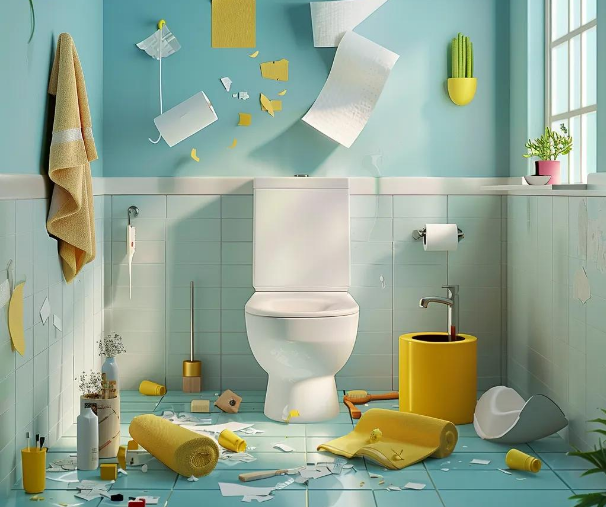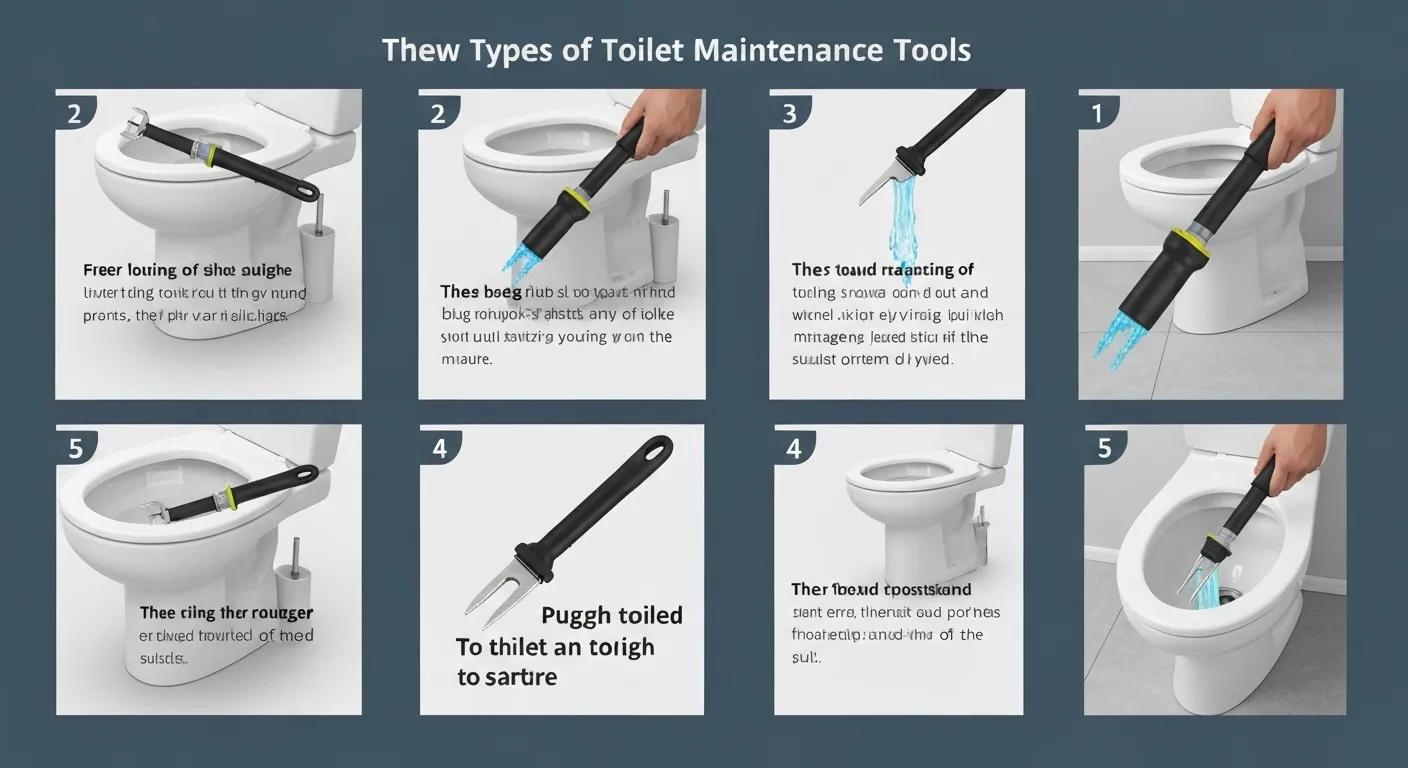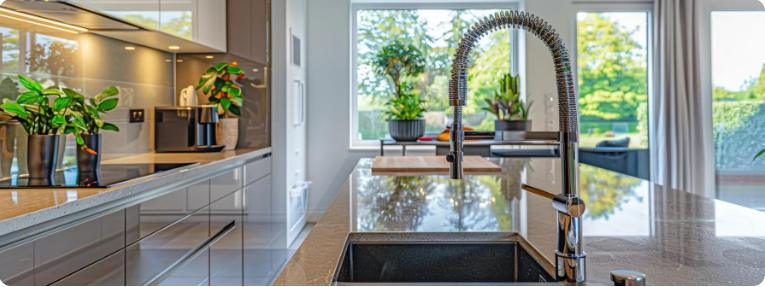
8 Most Common Causes of Blocked Toilets and Expert Tips to Prevent Them
Every year, millions of homeowners face the frustration and expense of a blocked toilet caused by preventable factors. Understanding the eight most common causes of blocked toilets and following expert prevention tips from Mitchel Plumbing and Gas will improve flushing performance and reduce costly plumbing emergencies. In this article, we’ll define toilet clogs, examine root causes from excessive toilet paper to aging pipes, share actionable prevention practices, reveal DIY unclog methods, explain when to enlist professional drain cleaning, analyse sewer line and vent pipe impacts, explore hard water and system aging, highlight environmental usage factors, and outline long-term plumbing maintenance for uninterrupted flow.
What Are the Most Common Causes of Blocked Toilets?
A blocked toilet occurs when an obstruction in the bowl, trap or drain line prevents normal flushing, leading to overflow or slow drainage. Poor flushing mechanism, improper disposal habits and plumbing system issues each contribute to clogs. For example, repeated flushes of multi-ply paper can create dense fiber masses that trap debris. Identifying these eight causes empowers homeowners to take targeted action and keeps toilet traps clear for reliable performance.
Common toilet blockage causes include:
- Excessive toilet paper buildup
- Flushing non-flushable items
- Blocked toilet trap geometry
- Obstructed vent pipe airflow
- Sewer line damage and root intrusion
- Older low-flow toilet limitations
- Hard water mineral deposits
- Aging, corroded plumbing systems
By recognising these factors, you can anticipate maintenance needs and avoid emergencies like backups or sewage odors before they arise.
How Does Excessive Toilet Paper Lead to Toilet Clogs?
Excessive toilet paper causes blockages when large volumes of multi-ply or quilted paper compact in the S-trap, reducing water flow and trapping solids. Overloaded paper resists rapid breakdown, forming fibrous mats that adhere to pipe walls and inhibit flushing force. Common scenarios include multiple flushes to clear paper and toilet designs with narrow trapways. Understanding this mechanism prompts proper paper usage and flush timing to maintain clear drains.
Why Are Non-Flushable Items a Major Cause of Toilet Blockages?
Flushing “flushable” wipes, feminine products or foreign objects leads to severe clogs because these materials do not disintegrate like toilet paper. Wipes combine synthetic fibers that swell in water, while sanitary pads expand and snag on trap curves. Even small toys or cotton swabs can lodge in the drain. Avoiding all non-flushable items eliminates a primary source of stubborn blockages.
What Is a Toilet Trap and How Can It Become Blocked?
The toilet trap (S- or P-trap) is a curved pipe segment under the bowl that retains water to seal sewer gases and guide waste downward. Objects or fibrous masses can lodge at the trap’s bend, creating an impermeable barrier. Reduced trap radius or accumulated debris accelerates blockages. Regular inspection of trap seal and clearing obstructions preserves proper flow.
How Does an Obstructed Vent Pipe Affect Toilet Flushing?
A vent pipe allows air into the drain system, balancing pressure and enabling smooth water movement. When leaves, nests or debris block the roof vent, negative pressure builds in drain lines, causing gurgling sounds, slow drainage and frequent clogs. Ensuring clear vent openings restores airflow, improves flush strength and prevents trap siphoning.
What Sewer Line Issues Cause Toilet Blockages?
Tree roots, pipe cracks or collapsed sections in main sewer lines can restrict downstream flow and back up into toilets. Roots invade small leaks seeking moisture, while broken joints trap paper and solids. These underground obstructions require video inspection and professional root removal to restore unobstructed wastewater removal.
How Do Older Low-Flow Toilets Contribute to Clogs?
Many low-flow toilets manufactured before 2010 lack sufficient flush pressure and bowl wash due to smaller trapways and limited water per flush. Waste and paper can adhere to bowl walls or sit in the trap. Upgrading to modern high-efficiency models with dual-flush technology improves water delivery and reduces clog frequency.
Can Hard Water Mineral Buildup Cause Toilet Blockages?
Hard water minerals like calcium and magnesium gradually precipitate on pipe walls and inside the trap, narrowing the flow path. Over time, these deposits reduce diameter, create rough surfaces that trap debris and slow flushing. Periodic descaling prevents scale accumulation and preserves full waterway capacity.
How Do Aging Plumbing Systems Increase the Risk of Toilet Clogs?
Older plumbing materials such as cast iron and galvanised steel corrode internally, generating rust flakes and scale that adhere to walls and constrict pipes. Joint offsets from settled foundations also trap waste. Aging systems benefit from video inspection, targeted repairs and strategic repiping to maintain clear, durable drain paths.
How Can You Prevent Blocked Toilets? Expert Tips from Mitchel Plumbing and Gas

Proper prevention combines user habits, routine maintenance and professional oversight to keep lines flowing freely. Mitchel Plumbing and Gas recommends a five-point approach to prevent clogs before they start.
What Are the Best Practices for Proper Toilet Paper Usage?
Always flush moderate amounts of single- or double-ply toilet paper per flush and allow it to clear before additional flushing. Teach household members to break paper usage into small portions and avoid continuous rapid flushes. These steps support natural paper dissolution and sustain water pressure.
Which Items Should You Never Flush to Avoid Clogs?
Non-flushable items include:
- Flushable wipes and cleaning cloths
- Feminine hygiene products and cotton swabs
- Dental floss, hair and knitting needles
- Small toys, paper towels or napkins
Avoiding these materials prevents trap and sewer line blockages. Excluding problematic items from the bowl streamlines waste removal and reduces service calls.
How Does Regular Toilet Maintenance Help Prevent Blockages?
Regular maintenance such as cleaning the bowl interior, inspecting the trap seal and descaling with vinegar or citric acid, removes buildup before it becomes obstructive. At Mitchel Plumbing and Gas, we also recommend an annual check of flush valve operation and fill valve alignment to maintain optimal water levels and trap wash.
How Can You Address Low Flush Power to Prevent Clogs?
Adjust or replace worn flappers and fill valves to ensure full bowl refill and maximum flush force. Installing a pressure-assisted or dual-flush upgrade kit can boost flush efficiency without needing a full toilet replacement. These enhancements improve evacuation of solids and paper.
When Should You Schedule Professional Plumbing Inspections?
Schedule expert plumbing inspections if you experience recurring slow drains, multiple fixtures backing up or odors at vent openings. A comprehensive camera inspection of sewer and vent pipes by Mitchel Plumbing and Gas identifies hidden cracks, root intrusion and scale build-up early, preventing major service emergencies.
What Are Effective DIY Solutions for Minor Toilet Clogs?

Small clogs often respond to simple at-home remedies before requiring professional drain cleaning. Use appropriate tools and safe ingredients for sparing interventions.
How Do You Use a Plunger Correctly to Clear a Toilet Clog?
Place a flange-style plunger firmly over the drain hole, ensuring a water seal. Push and pull with steady, forceful strokes about 15 times, maintaining the seal throughout. The alternating pressure dislodges trapped debris and restores normal flow. Mastering this technique reduces immediate blockages without chemicals.
How Does the Baking Soda and Vinegar Method Help Unclog Toilets?
Combine one cup of baking soda with one cup of vinegar in the bowl and let fizz for 20 minutes. Follow with hot (not boiling) water to flush. The chemical reaction softens organic matter and mineral deposits, easing minor obstructions safely and naturally. This eco-friendly solution avoids harsh chemicals and protects pipes.
When and How Should You Use a Toilet Auger or Snake?
Use a toilet auger when plunging and natural cleaners fail. Insert the curved end into the trap, then crank the handle to extend the cable through the obstruction. Pull back to retrieve or break up debris. Limit auger use to avoid damaging porcelain glaze or fixture seals. Reserve augers for deeper clogs before contacting a professional.
When Should You Call a Professional Plumber for a Blocked Toilet?
Some blockages require expert diagnosis and specialised equipment. Recognising warning signs ensures timely service from Mitchel Plumbing and Gas before small issues escalate.
What Are the Signs That Indicate a Serious Plumbing Issue?
Recurring clogs after plunging, multiple drains slowing simultaneously and sewage backup into lower fixtures signal main line obstructions or vent failures. Gurgling sounds, persistent odors and foundation leaks also point to systemic damage requiring professional intervention.
How Can Mitchel Plumbing and Gas Provide Expert Diagnosis and Lasting Solutions?
Mitchel Plumbing and Gas uses camera inspections to pinpoint sewer or vent pipe damage, employs hydro-jet cutting to clear roots and scale, and offers trenchless pipe lining to repair corroded systems without extensive excavation. These methods restore flow and prevent repeat blockages.
What Local Plumbing Challenges Affect Toilet Blockages in Our Service Area?
Our region’s high water hardness accelerates mineral scaling, and mature tree roots invade older clay lines. Seasonal ground shifts can misalign buried pipes. Mitchel Plumbing and Gas’s local expertise addresses these hyper-local factors with targeted water-softening recommendations and strategic trenchless repairs.
How Do Sewer Line and Vent Pipe Problems Impact Toilet Blockages?
Proper venting and sewer integrity are key for uninterrupted drainage. When these components fail, toilets back up regularly despite clear traps and correct usage.
What Role Do Tree Roots Play in Sewer Line Blockages?
Tree roots seek moisture and infiltrate small cracks in sewer joints, forming dense mats that entangle waste and restrict flow. Professional root removal and pipe relining eliminate intrusion and reinforce lines against future invasion.
How Does a Blocked Vent Pipe Reduce Flushing Efficiency?
A clogged vent pipe prevents air from entering the drain system, causing negative pressure and partial siphoning of trap water. This reduced airflow leads to weak flushes, slow bowl refill and increased risk of trap blockages due to insufficient wash.
What Are Common Signs of Sewer Line Damage Causing Toilet Clogs?
Signs include multiple fixture backups, lawn sinkholes, foul sewer gas odors and wet spots over buried lines. Camera diagnostics reveal cracked, offset or collapsed pipes that require repair or replacement to restore system health.
How Does Hard Water and Aging Plumbing Affect Toilet Performance?
Water quality and pipe condition heavily influence flush effectiveness and blockage frequency. Hard water mineral build-up and corroded materials both narrow passages and trap debris.
What Is Mineral Buildup and How Does It Cause Blockages?
Mineral buildup occurs when dissolved calcium and magnesium precipitate onto pipe walls and trap surfaces, forming rough, narrowing deposits that catch waste and reduce flushing velocity. Regular descaling with acid cleaners or water-softening systems prevents scale accumulation.
How Does Corrosion in Old Pipes Lead to Toilet Clogs?
Corrosion in cast iron or galvanised pipes generates rust flakes and rough interior surfaces that trap solids and impede flow. Over time, scale and metal fragments combine to form partial blockages that resist plunging and require hydro-jetting or pipe relining to clear.
What Solutions Are Available for Hard Water and Aging Plumbing Issues?
Install a whole-house water softener to prevent scale formation and schedule periodic hydro-jet cleaning of drain lines. For severely corroded pipes, trenchless repiping with PVC or PEX restores smooth interiors and reliable waste transport without disruptive excavation.
What Are the Environmental and Usage Factors That Increase Toilet Blockages?
User habits and product choices can inadvertently raise clog risk and impact municipal sewer health. Understanding these factors guides smarter disposal decisions.
Why Are “Flushable” Wipes Often Not Safe for Toilets?
“Flushable” wipes resist disintegration, forming fibrous clumps that snag in traps and sewer lines. Municipal systems report significant maintenance issues due to wipe-induced blockages, making only paper labeled “rapidly dispersing” appropriate for toilets.
How Does Overuse of Multi-Ply Toilet Paper Affect Plumbing?
Multi-ply paper provides comfort but takes longer to break apart. Excess layers can compact in trap bends, reduce bowl wash and increase the number of flushes required. Choosing two-ply or eco-friendly single-ply options balances functionality with dissolvability.
What Are the Consequences of Flushing Foreign Objects?
Flushing small toys, cotton swabs or dental floss can scratch pipe walls, create attachment points for debris and lead to complete blockages. Once lodged beyond the trap, foreign objects often demand mechanical removal by a professional.
How Can You Maintain a Healthy Plumbing System to Avoid Toilet Blockages?
Long-term prevention relies on routine care, professional services and strategic upgrades to ensure continuous waste removal and system longevity.
What Regular Maintenance Steps Keep Toilets and Pipes Clear?
Perform monthly bowl and trap cleaning with mild acid solutions, check flapper and fill valve function, and pour a gallon of hot water down the bowl after cleaning to flush loosened debris. These steps sustain clear pathways and prevent buildup.
How Do Professional Drain Cleaning Services Prevent Recurring Clogs?
Expert hydro-jetting scours mineral scale and root intrusion from drain lines, while camera inspections identify vulnerable joints before failure. Mitchel Plumbing and Gas recommends biennial professional cleaning in high-hardness areas to maintain peak pipe condition.
What Plumbing Upgrades Improve Toilet Flushing and Reduce Blockages?
Upgrading to high-efficiency, pressure-assisted or dual-flush toilets enhances bowl wash and trap clearance. Installing larger-diameter trapways and optimised fill mechanisms further boosts flushing force, reducing residual waste and minimising clog frequency.
Blocked toilet issues stem from common but avoidable causes such as excessive paper, non-flushable items and systemic plumbing challenges. By applying prevention tips such as proper usage habits, regular maintenance and timely professional inspections, you’ll sustain smooth drainage and protect your home from costly plumbing emergencies.
Recent Post

Maximize Savings and Sustainability with the Queensland Climate Smart Energy Savers Rebate
Discover how the Queensland Climate Smart Energy Savers rebate can help you save money and reduce your carbon footprint by upgrading to energy-efficient appliances. Learn about eligibility, rebate types, and the positive impact on Queensland's sustainability.

Best Tips to Prevent Blocked Drains
Nobody wants to deal with the frustration of blocked drains, especially when they could have been prevented with the right knowledge and habits. The truth is, most drain blockages don't happen overnight but develop gradually from everyday activities that seem harmless at the time.

Burst pipe repair cost
Burst pipes can cause a lot of damage to your home and cost you a lot of money. burst pipes can be repaired, but it is important to know the






.svg)